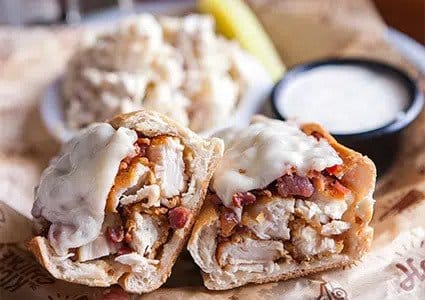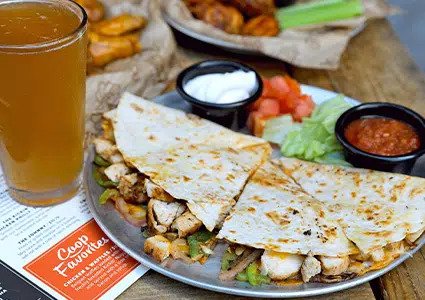Sports Bar in Downtown Charleston, SC

We'd like to welcome you the coolest coop in Downtown Charleston: The Kickin' Chicken. Life in the Lowcountry is all about laid-back vibes and fun times, and we serve up those same experiences alongside our famous coop favorites seven days a week.
Whether you're gathering friends and family for game day or want a fresh, fast dinner for the two of you, we've got something to meet everyone's needs. Downtown Charleston residents love to eat at our restaurants because we know what they like to eat, drink, and play. No, we didn't conduct surveys and focus groups to get that conclusion - owners Chip Roberts and Bobby Perry grew up right here in Charleston. Like many Chucktown natives, they attended the University of South Carolina before finding their path in life.
After graduating college, Chip and Bobby saw a chance to add to the delicious food culture in Charleston. In 1997, Bobby and Chip partnered up to start Charleston's favorite bar and grill: The Kickin' Chicken. If you've ever visited our restaurant, you know it was never meant to be a fancy, sit-down eatery. Instead, Chip and Bobby envisioned serving fresh, delicious food to their fellow Charlestonians in a fun and enjoyable atmosphere.
After opening their first location in Charleston, Bobby and Chip knew they had something special on their hands. After building a loyal fanbase and experimenting with the recipe for its now-famous Kickin' Chicken sandwich, it was time to expand.
To help facilitate that expansion, David Miller came onboard after they opened a second location. Finally, with the guidance and knowledge that David brought, the Kickin' Chicken had become a staple in South Carolina and an incredibly popular sports bar in Downtown Charleston, SC.
Today, we're still cooking up fresh, tasty meals and great times at all our locations around metro Downtown Charleston. We're proud to be Lowcountry natives and strive for excellence with every plate and drink we deliver to your table or front door.
843.766.5292
Closed for Maintenance and Repairs
Our hours
| Day | Hour |
|---|---|
| Sunday - Thursday | 11 am -10 pm |
| Friday - Saturday | 11 am - 11 pm |
Welcome to Your New Favorite Bar and Grill in Downtown Charleston, SC
Our sports bar wouldn't be what it is without a menu full of coop favorites, signature sandwiches, and cold beverages. Here are just a few of our customer's go-to dishes and drinks to enjoy at Kickin' Chicken:
Starters
They say first impressions make a world of difference. Our starters are sure to whet your appetite and show your stomach how serious we are about making it happy.

Bobby Fries
"I'll just eat half of those Bobby Fries now, and I'll save the rest for later," is a phrase that nobody says. Why? Because our Bobby Fries are basically heaven on earth, and it's almost impossible to put them down. We start with sizzling, fresh fries hot out of the fryer and top them with creamy ranch dressing, crispy bacon bits, and a blanket of melted cheeses. We then serve them straight to your table or house, so you can dig in even if you're not dining out.

Fried Pickles
Lightly breaded and fried to golden-brown perfection, our fried pickles are equal parts tangy and tasty. With a cup of cool ranch served on the side, it's hard to quit dipping these crispy pickle chips. Order up a batch or two to enjoy with friends on college gameday or as a precursor to your memorable meal at Kickin' Chicken.

Kickin' Nachos
Get ready for one of the biggest, best plates of nachos that you've ever seen in a Downtown Charleston sports bar. We start with a heaping helping of crispy, crunchy tortilla chips and top them with our indulgent house queso. We then add melty mixed cheese, crisp lettuce, cool tomato, onion to the mix, so you can say you ate your veggies. We top it all off with zesty jalapenos for a little extra kick.
Chicken, Rubs, & Sauces
Our chicken dishes helped put us on the map, so be sure you try one or all of our fresh-made choices of fried poultry perfection.

Wings
Whether you're "winging" in the weekend or need football-day food for your whole crew at the bar, our famous chicken wings are a crowd favorite at Kickin' Chicken. Hot and crispy on the outside and tender and juicy inside, you can't go wrong with fried chicken wings, especially when friends are near and sports is on the TV. Sauce up your wings with flavors like buffalo, Nashville hot, hot honey garlic, Polynesian, or pterodactyl. Or, if you prefer, let us rub your meat with lemon pepper, ranch, spicy ranch, or Jamaican jerk. The choice is yours, and none of them are wrong.

Kickin' Nuggets
A world without great chicken nuggets is a world we don't want to live in. That's why we made our own! Our fresh-cut, hand-breaded, all-white meat nuggets are served with fries and your choice of honey mustard or ranch for dipping.

Kickin' Tenders
Our marinated chicken tenders are big, juicy, and hand-breaded in our unique blend of spices. You won't find these plump tenders at any fast-food drive-thru! Before we deliver your Kickin' Tenders, we load up your plate with crispy fries and add a cup of honey mustard for dipping. Concerned about your cardio? Order your tenders grilled instead of fried!
Signature Wraps & Sandwiches
Our Kickin' Chicken wraps and sandwiches are handheld masterpieces that will leave your tummy full of joy.

The Kickin' Chicken
This sandwich is the one that started it all! We pile tender, juicy chicken and crispy bacon into a soft sandwich roll and cover it with a melty blanket of provolone cheese. With a side of our extra-special sauce for dipping, this is chicken sandwich nirvana that you can only find at our bar and grill in Downtown Charleston, SC.

The Johnny
Want to take your Kickin' Chicken to the next level? Our The Johnny takes all the best things about our original version and adds that spicy tang that you're craving. This fan-favorite comes with your choice of french fries, pasta salad, coleslaw, or potato chips, complete with ranch or bleu cheese for dipping.

Boss Burger
Cheddar cheese, onion straws, lettuce, tomato, smoky BBQ aioli.
Coop Favorites
Like the famous Kickin' Chicken sandwich, our Coop Favorites are uniquely us and full of Lowcountry love and flair.

Kickin' Quesadilla
In "queso" you didn't know, you can sponsor your good mood with our take on this classic bar food staple! We take your pick of chicken, shrimp, or veggies, add mixed cheese, onions, and peppers, and grill it to perfection. We then deliver it to your door or table with fresh salsa and yummy sour cream to complete this masterpiece.

Chicken & Waffles
Crispy fried chicken. Pillowy-soft Belgian waffles. A side of salty bacon and sweet syrup. Breakfast for dinner never sounded so great!
Salads
Our salads are tasty, lean, and green to help your body keep running like a machine. With unique salad dressings and awesome add-ons, your new favorite dish might just be doctor recommended.

The Southwest Salad
Our house salad topped with black bean & corn mix, and tortilla crisps. Served with our creamy cilantro lime. Add Chicken $5, Shrimp $6, Veggie Burger $5.

The Kickin' Chicken Salad
A refreshing salad topped with your choice of fried or grilled chicken, this salad is far from rabbit food, and will leave you feeling full without having to unbutton your pants.
Latest News Near Me Downtown Charleston, SC
Saturday night’s high tide, additional rain boosted Charleston flood risk
Nick Reaganhttps://www.live5news.com/2025/08/23/its-insane-saturday-nights-high-tide-expected-make-flooding-conditions-even-worse/
CHARLESTON, S.C. (WCSC) - The National Weather Service issued a coastal flood warning for Charleston and coastal Colleton Counties ahead of Saturday night’s high tide and additional showers that moved in from offshore.High tide occurred at approximately 9:04 p.m., but saltwater inundation was possible for up to two hours after that. The coastal flood warning was set to expire at midnight.Live 5 First Alert Meteorologist Lexie Horvath said the Charleston area recorded more than 10 inches of rain over the past 24 hours and ...
CHARLESTON, S.C. (WCSC) - The National Weather Service issued a coastal flood warning for Charleston and coastal Colleton Counties ahead of Saturday night’s high tide and additional showers that moved in from offshore.
High tide occurred at approximately 9:04 p.m., but saltwater inundation was possible for up to two hours after that. The coastal flood warning was set to expire at midnight.
Live 5 First Alert Meteorologist Lexie Horvath said the Charleston area recorded more than 10 inches of rain over the past 24 hours and more rain moved in offshore late Saturday night.
That meant already flooded areas could have gotten even worse, something that concerns residents like Omar Santiago.
“We’re walking around, you know, the water’s right up basically to our knees. It’s insane,” he said. “I felt like I was back home in Puerto Rico, like, it was crazy.”
Rising water from two days of rainfall that exceeded 10 inches in the Charleston area prompted multiple road closures.
“In my 35 years of life, this is the worst flooding I’ve ever seen,” Santiago said. “It’s just unbelievable.”
See flooding in your area? Snap a photo and upload it to us by clicking the blue “+ADD MEDIA” button:
Torrential rain, coastal flooding and water running off the Interstate 26 overpass in downtown Charleston on Saturday left Poplar Street a wet, muddy mess.
Regina Duggins’ mother lives at the end of the street where the flooding was the worst. She says she worries about her mother and other elderly residents living in the area. She says for more than 20 hours her mother’s house was surrounded by water, making it difficult for her to leave or others to get to her.
“If there was an emergency, there’s no way to get in and out,” Duggins said. “This is deplorable.”
Duggins says normally water recedes quickly, but this time it stayed around much longer than usual. She blames clogged storm drains and has contacted city officials to get them cleaned.
For now, Duggins is happy the water has receded, but she still has concerns for the future.
“I do feel a sense of relief, but at the same time, I don’t know what to expect due to the fact that it is supposed to rain some more this evening and possibly tomorrow, but this was not even a hurricane, and we’re still in hurricane season until mid-November, so I don’t know what to expect,” Duggins said.
A flood watch will remain in effect for most Lowcountry counties until 2 a.m. Sunday.
Urgent Flood Warning Issued for Hundreds of Thousands: 'Act Now'
Anna Skinnerhttps://www.newsweek.com/urgent-flash-flood-warning-charleston-south-carolina-2117932
Hundreds of thousands of residents in Charleston, South Carolina, were urged to "act now" after National Weather Service (NWS) meteorologists issued urgent flash flood warnings for the area amid slow-moving thunderstorms and torrential rainfall.Why It MattersFlooding is the second deadliest weather hazard in the United States, behind extreme heat. The current storms in South Carolina come just after Hurricane Erin brought dangerous waves and life-threatening rip currents to the entire Eastern Seaboard earlier this w...
Hundreds of thousands of residents in Charleston, South Carolina, were urged to "act now" after National Weather Service (NWS) meteorologists issued urgent flash flood warnings for the area amid slow-moving thunderstorms and torrential rainfall.
Why It Matters
Flooding is the second deadliest weather hazard in the United States, behind extreme heat. The current storms in South Carolina come just after Hurricane Erin brought dangerous waves and life-threatening rip currents to the entire Eastern Seaboard earlier this week, although the ongoing storms aren't related to the hurricane, NWS meteorologist Alex Trellinger told Newsweek.
What to Know
NWS Charleston issued flash flood warnings across multiple media platforms on Friday, urging people in Downtown Charleston to move vehicles to higher ground and warning that floodwaters could enter homes.
"ALERT: If you are in Downtown Charleston, consider moving to your car to higher ground now," NWS Charleston posted on X on Friday afternoon. "The risk for flash flooding will increase rapidly very soon. Expect road closures to occur. Water may also enter homes, businesses and properties. Act now."
As of 1:22 p.m. local time, over 40 roads were closed in Downtown Charleston because of flooding. Roads are also closed in Mount Pleasant and North Charleston.
The slow-moving thunderstorms stretched from North Charleston and Daniel Island south to Rockville and Kiawah Island. As much as 3 inches of rain has been reported in the area, with an additional 1 to 2 inches possible this afternoon.
"Flash flooding is ongoing in many areas and will continue. A new daily rainfall record has already been set at the Charleston International Airport," NWS Charleston said in a flash flood warning.
As of 12:39 p.m. local time, the airport reported 2.95 inches of rain, which "smashes" the previous daily rainfall record for August 22, which was 1.58 inches set in 2008, NWS Charleston said in a post on X.
An additional .02 inches of rain has fallen at the airport since the post was made.
"Additional rainfall is likely," NWS Charleston posted on X.
Read more South Carolina
What People Are Saying
NWS Charleston, in a flash flood warning: "At 109 PM EDT, emergency management officials reported a number of flooded and closed roads in the Mount Pleasant area. Radar shows thunderstorms with torrential rainfall continuing to impact Mount Pleasant, Isle of Palms and Sullivans Island. An additional 1 to 2 inches could fall through 230 PM. The risk for additional flash flooding continues."
Charleston Water, on X: "Avoid flood water! Stormwater contains high levels of bacteria, whether or not wastewater is involved."
Fox 24 reporter Bill Burr, on X: "Swollen creeks and ponds in Shadowmoss Plantation are leading to flooded roads. A late morning storm dumped copious amounts of rain in a short period of time."
What Happens Next
The flash flood warning was originally set to expire at 1:15 p.m. ET, but has since been extended to 2:30 p.m.
Jazz, funk, soul and spirituals will take over historic downtown Charleston for 11-day festival
Chelsea Grinsteadhttps://www.postandcourier.com/charleston_scene/arts/moja-arts-festival-charleston-sc/article_7a84e14f-784d-4775-aa03-10ed7f680d79.html
Different forms of artistic expression converge every year at MOJA Arts Festival, an 11-day festival honoring African American and Caribbean culture with performances and gatherings scattered across downtown Charleston.For its 41st year, MOJA returns Sept. 25 through Oct. 5 with nearly 30 events spanning visual art, live music, dance, theater and storytelling. This year’s lineup blends well-loved traditions — including the opening day street parade and the grand finale in Hampton Park — with new experiences such as S...
Different forms of artistic expression converge every year at MOJA Arts Festival, an 11-day festival honoring African American and Caribbean culture with performances and gatherings scattered across downtown Charleston.
For its 41st year, MOJA returns Sept. 25 through Oct. 5 with nearly 30 events spanning visual art, live music, dance, theater and storytelling. This year’s lineup blends well-loved traditions — including the opening day street parade and the grand finale in Hampton Park — with new experiences such as Step Afrika! dance troupe and a haunting play entitled “Covenant.”
The Eastside Neighborhood Celebration on Sept. 27 promises a family-friendly day in Hampstead Square with artisans, food trucks, drumming, dance and music by guitarist Greg Loney.
The Oct. 1 Downtown Block Party will transform Ann Street and the Bus Shed into a community hub filled with vendors, food and a musical tribute to Black icons by Charleston-born vocalist Tommy Brown.
Brown presented a tribute to the late Frankie Beverly last year at MOJA, and he is back this year to honor Black icons who have passed away in 2025, including iconic soul singer Jerry Butler; Roy Ayers, the “Godfather of Neo Soul”; Grammy-winning singer and pianist Robert Flack; South Carolina rapper and songwriter Angie Stone; and the legendary multi-instrumentalist Sly Stone of Sly and the Family Stone.
“We have a wide range of music, from Angie’s R&B vibe and Sly’s funky vibe to Jerry’s soul vibe,” Brown said. “We are going to put all that together and make it match my vibe. We want people dancing, and we also want to pay respect to these artists who have passed. We are going to give the block party on Ann Street what we gave it last year, which is a really good time.”
On Oct. 3, The Gullah Collective will showcase the deep roots of Gullah art and music at the Dock Street Theatre. The festivities then draw to a close on Oct. 5 with a free grand finale concert in Hampton Park featuring Live in the Flesh.
Owner proposes demo of downtown Charleston building
Melissa Rademakerhttps://www.live5news.com/2025/09/04/owner-proposes-demo-downtown-charleston-building/
CHARLESTON, S.C. (WCSC) - The owner of a building on Meeting Street in downtown Charleston that houses three businesses has asked the city’s architecture review board for permission to demolish the structure fully.280 Meeting Street houses three shops: The Bicycle Shoppe, 319 Men and Theatre 99. Tenants of the building declined to comment or did not respond to requests for comment by the time of publishing.The building was constructed in parts, with the principal structure in the 1910s, a one-story showroom addition in 19...
CHARLESTON, S.C. (WCSC) - The owner of a building on Meeting Street in downtown Charleston that houses three businesses has asked the city’s architecture review board for permission to demolish the structure fully.
280 Meeting Street houses three shops: The Bicycle Shoppe, 319 Men and Theatre 99. Tenants of the building declined to comment or did not respond to requests for comment by the time of publishing.
The building was constructed in parts, with the principal structure in the 1910s, a one-story showroom addition in 1951 and a rear accessory structure in 1952.
Anna Catherine Alexander, Director of Advocacy at the Preservation Society of Charleston, says in recent years, the board has entertained numerous requests for demolition on mid-century buildings in particular.
“This building at 280 Meeting Street has a really unique and kind of evolving history where the oldest part of the building dates to the early 20th century, and then the one-story showroom portion of the building dates to the 1950s. We’ve got a variety of architectural periods represented,” Alexander says.
The review committee is accepting online public comment through Sept. 9 at 12 p.m.
The committee will visit the site on Tuesday ahead of its Wednesday meeting. As of Thursday, the agenda item had received more than 200 online comments.
“We think that speaks volumes about the need to preserve this space, not only as a representation of its time, but for all of the continued uses that can continue to occupy this space. Adaptive reuse is critically important as we think about the evolution of our city and these buildings were built to serve multiple functions over time. This building has many lives left ahead of it,” Alexander says.
The demolition request does not specify any reasoning for the demo or propose what the space could be used for if it is granted. The owner is listed as W.E. Applegate III of 280 Meeting Street Associates LLC and the applicant for the work is listed as Eddie Bello of Bello Garris Architects.
Historians say in a city of history that often dates back hundreds of years, a building like this may not seem old, but its contribution to the city’s recent life and story should be taken into account.
“It’s important that Charleston’s architecture tells a full story of the periods of development and the people who have called this place home, who have occupied these businesses. 280 Meeting Street is an important representation of early and mid-20th-century development. It’s been an incubator for locally owned businesses, and clearly has been demonstrated through the community input. It’s a place that really matters to people,” Alexander says.
Contextually, a neighboring one-story office at 284 Meeting Street was approved for demo in 2024. A condo complex is now being built on the property next door. Alexander encourages people interested in providing a comment online or to consider attending the meeting.
“A space for small businesses, a space for arts and culture to continue to thrive on Meeting Street - all of this is at risk if this building is lost. And we really hope that the Board of Architectural Review will hear it loud and clear that this is a space the community values and should be protected,” Alexander says.
Disclaimer:


